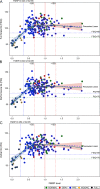Association between IQ and FMR1 protein (FMRP) across the spectrum of CGG repeat expansions
- PMID: 31891607
- PMCID: PMC6938341
- DOI: 10.1371/journal.pone.0226811
Association between IQ and FMR1 protein (FMRP) across the spectrum of CGG repeat expansions
Abstract
Fragile X syndrome, the leading heritable form of intellectual disability, is caused by hypermethylation and transcriptional silencing of large (CGG) repeat expansions (> 200 repeats) in the 5' untranslated region of the fragile X mental retardation 1 (FMR1) gene. As a consequence of FMR1 gene silencing, there is little or no production of FMR1 protein (FMRP), an important element in normal synaptic function. Although the absence of FMRP has long been known to be responsible for the cognitive impairment in fragile X syndrome, the relationship between FMRP level and cognitive ability (IQ) is only imprecisely understood. To address this issue, a high-throughput, fluorescence resonance energy transfer (FRET) assay has been used to quantify FMRP levels in dermal fibroblasts, and the relationship between FMRP and IQ measures was assessed by statistical analysis in a cohort of 184 individuals with CGG-repeat lengths spanning normal (< 45 CGGs) to full mutation (> 200 CGGs) repeat ranges in fibroblasts. The principal findings of the current study are twofold: i) For those with normal CGG repeats, IQ is no longer sensitive to further increases in FMRP above an FMRP threshold of ~70% of the mean FMRP level; below this threshold, IQ decreases steeply with further decreases in FMRP; and ii) For the current cohort, a mean IQ of 85 (lower bound for the normal IQ range) is attained for FMRP levels that are only ~35% of the mean FMRP level among normal CGG-repeat controls. The current results should help guide expectations for efforts to induce FMR1 gene activity and for the levels of cognitive function expected for a given range of FMRP levels.
Conflict of interest statement
RJH has received funding for studies of treatment in FXS from Zynerba and Ovid. PJH has received support for studies from BioMarin and is on the scientific advisory board of NeuCyte. DH has received funding for outcome measure research from Ovid and Zynerba. This does not alter our adherence to PLOS ONE policies on sharing data and materials.
Figures


Similar articles
-
FMR1 Protein Expression Correlates with Intelligence Quotient in Both Peripheral Blood Mononuclear Cells and Fibroblasts from Individuals with an FMR1 Mutation.J Mol Diagn. 2024 Jun;26(6):498-509. doi: 10.1016/j.jmoldx.2024.02.007. Epub 2024 Mar 22. J Mol Diagn. 2024. PMID: 38522837 Free PMC article.
-
Epigenetic characterization of the FMR1 gene and aberrant neurodevelopment in human induced pluripotent stem cell models of fragile X syndrome.PLoS One. 2011;6(10):e26203. doi: 10.1371/journal.pone.0026203. Epub 2011 Oct 12. PLoS One. 2011. PMID: 22022567 Free PMC article.
-
CNS expression of murine fragile X protein (FMRP) as a function of CGG-repeat size.Hum Mol Genet. 2014 Jun 15;23(12):3228-38. doi: 10.1093/hmg/ddu032. Epub 2014 Jan 23. Hum Mol Genet. 2014. PMID: 24463622 Free PMC article.
-
[FMR1 PREMUTATION CARRIERS - ARE THEY REALLY ASYMPTOMATIC?].Harefuah. 2018 Apr;157(4):241-244. Harefuah. 2018. PMID: 29688643 Review. Hebrew.
-
Expression of the FMR1 gene.Cytogenet Genome Res. 2003;100(1-4):124-8. doi: 10.1159/000072846. Cytogenet Genome Res. 2003. PMID: 14526172 Review.
Cited by
-
A near normal distribution of IQ in Fragile X Syndrome.Sci Rep. 2024 Oct 4;14(1):23058. doi: 10.1038/s41598-024-73626-y. Sci Rep. 2024. PMID: 39367109 Free PMC article.
-
Raising Knowledge and Awareness of Fragile X Syndrome in Serbia, Georgia, and Colombia: A Model for Other Developing Countries?Yale J Biol Med. 2021 Dec 29;94(4):559-571. eCollection 2021 Dec. Yale J Biol Med. 2021. PMID: 34970093 Free PMC article.
-
Unmethylated Mosaic Full Mutation Males without Fragile X Syndrome.Genes (Basel). 2024 Mar 3;15(3):331. doi: 10.3390/genes15030331. Genes (Basel). 2024. PMID: 38540390 Free PMC article. Review.
-
Dosage sensitivity to Pumilio1 variants in the mouse brain reflects distinct molecular mechanisms.EMBO J. 2023 Jun 1;42(11):e112721. doi: 10.15252/embj.2022112721. Epub 2023 Apr 18. EMBO J. 2023. PMID: 37070548 Free PMC article.
-
Diagnostic value of molecular approach in screening for fragile X premutation cases.Ir J Med Sci. 2023 Oct;192(5):2265-2272. doi: 10.1007/s11845-022-03166-9. Epub 2022 Nov 21. Ir J Med Sci. 2023. PMID: 36409419 Free PMC article.
References
Publication types
MeSH terms
Substances
Grants and funding
LinkOut - more resources
Full Text Sources
Medical
Research Materials

